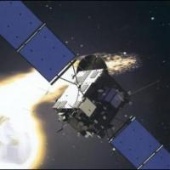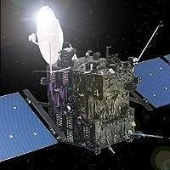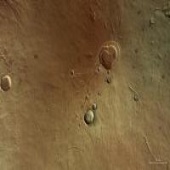ESA Science & Technology - Status Report Archive
Status report archive
Status report archive
The spacecraft is now flying its 288th orbit, in good status and with all functions performing nominally. The new thrusting strategy is well in progress with thrust arcs around perigee for about one third of every revolution. Presently the thrust arcs last for about 15 hours of every 42 hour-orbit. The thrust duration will progressively increase...
Published: 14 May 2004
Overall Mission StatusThe overall operational performance of all spacecraft subsystems is good. Following difficulties encountered with the Solid State Mass Memory (SSMM) in the March-April timeframe, the upload of a new Solid State Mass Memory software version took place successfully in mid-April. No science operations were possible during the...
Published: 11 May 2004
Report for week 30 April to 7 MayPayload commissioning activities continued in the reporting period. For the first time a scientific activity was executed: the observation of comet Linear. Four remote sensing instruments, MIRO, ALICE, VIRTIS and OSIRIS took measurements and images during this special pointing operation.
Published: 10 May 2004
Report for week 23 to 30 April 2004Payload commissioning activities continued in the reporting period. For the first time the spacecraft was rotated such that the payload could point towards the Earth. This gave MIRO and VIRTIS the opportunity to take calibration measurements using the Earth as a target.
Published: 3 May 2004
The spacecraft is now in its 278th orbit, in good status and with all functions performing nominally. The new thrusting strategy is well in progress with thrust arcs around perigee for about one third of every revolution. Presently the thrust arcs last for about 13 hours of every 36 hour-orbit. The thrust duration will increase to 18 hours when...
Published: 28 April 2004
Report for week 16 to 23 April 2004Payload commissioning activities continued in the reporting period. The main activity was the completion of the second ALICE commissioning slot. In support of the ALICE high voltage operations the ROSINA COPS pressure monitor was active for most of the time.
Published: 26 April 2004
Report for week 9 to 16 April 2004Payload commissioning activities continued in the reporting period. The main activity was the second commissioning slot of the Lander, mainly dedicated to Lander payload operations. All activities were successfully completed, with the exception of a few procedures that will have to be repeated in Lander slot 3...
Published: 19 April 2004
Report for week 3 to 9 April 2004Payload commissioning activities have reached an important milestone in the reporting period: all scientific instruments have been activated at least once since the beginning of the mission.
Published: 13 April 2004
The spacecraft is now flying its 264th orbit, in good status and with all functions performing nominally. After the eclipse season, the new thrusting strategy is progressing well with long thrust arcs around perigee occurring every orbit for about 10.5 hours. During the coming month this will be increased to 14 hours per orbit.
Published: 7 April 2004
Report for week 26 March to 2 AprilPayload commissioning activities continued in the reporting period. The Radio Science Instrument (RSI) commissioning covered the first four passes, followed by the initial activation and commissioning of the MIRO instrument.
Published: 5 April 2004
Overall Mission StatusSince the last status report, the overall operational performance of the spacecraft and payload continued to be satisfactory. Some temporary problems were encountered with the Solid State Mass Memory (SSMM), which are currently under investigation.
Published: 31 March 2004
Report for week 19 to 26 MarchPayload commissioning activities continued in the reporting period. Three instruments were activated for the first time, ROSINA, ALICE and VIRTIS, and their first slot of commissioning activities successfully completed.
Published: 26 March 2004
Report for week 12 to 19 MarchSince the last status report there have been two major areas of commissioning activity: for the first five days the focus was on the lander; followed later by the various plasma detection packages on the orbiter.
Published: 24 March 2004
The spacecraft has completed over 250 orbits, is in good status and with all functions performing nominally. The eclipse season is now over, with the last eclipse occurring on 21 March. The longest eclipse occurred on 13 March (lasted for 2 hours and 15 minutes) and stressed the power systems to their maximum limit. The spacecraft performed...
Published: 22 March 2004
The China-ESA Double Star project is designed to use two spacecraft to study the Earth's magnetosphere, in concert with ESA's four spacecraft Cluster mission. The Double Star spacecraft are known as TC-1 and TC-2, or translating to English, as Explorer-1 and Explorer-2.
Published: 18 March 2004
SummaryIn the reporting period the Rosetta control at ESOC has been moved to the Dedicated Control Room, ground coverage has been reduced to a single ground station (New Norcia, covering about 12 hours per day) and spacecraft and payload commissioning activities have begun.
Published: 15 March 2004
SummaryThe spacecraft and ground segment continue to operate well. All activities planned for the initial, critical phase after launch have been successfully completed ahead of schedule. In the early morning of 5 March the Mission Control Team at ESOC has moved from the Main Control Room to the Rosetta Dedicated Control Room to commence the...
Published: 8 March 2004
The spacecraft is now in its 233rd orbit, in good status and with all functions performing nominally. Starting on 24 February 2004 operation of the electric propulsion drive was resumed. The engine is turned on every orbit around perigee for about 1.5 hours.
Published: 4 March 2004
Launch SummaryAriane 5 Flight 158 lifted off right on-schedule at 07:17:51 UTC on 2 March carrying with it the Rosetta spacecraft on the start of its 10 year journey to comet Churyumov-Gerasimenko.
Published: 4 March 2004
Overall Mission StatusThe mapping orbit of Mars Express was reached on 28 January 2004. All manoeuvres leading to that orbit were executed with very high accuracy. The operational performance of the spacecraft and payload is excellent, and all instruments have been successfully checked out. Remaining commissioning activities will be performed...
Published: 19 February 2004
—
20 Items per Page




















